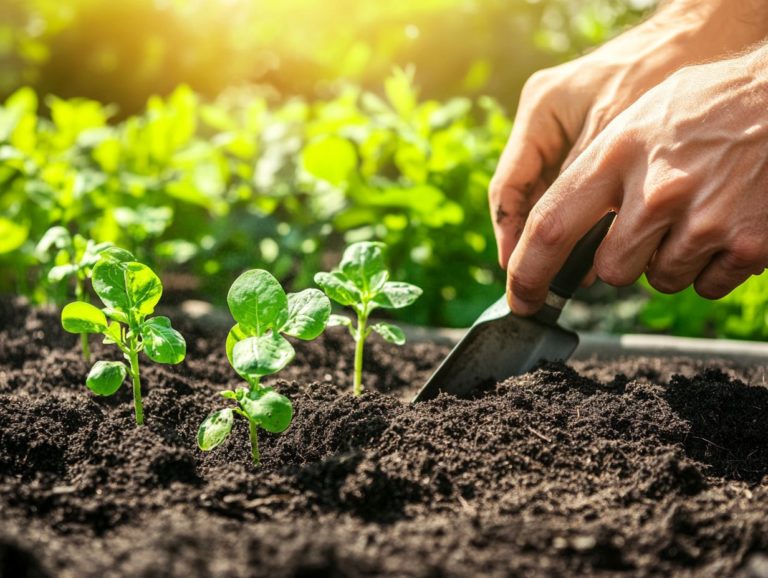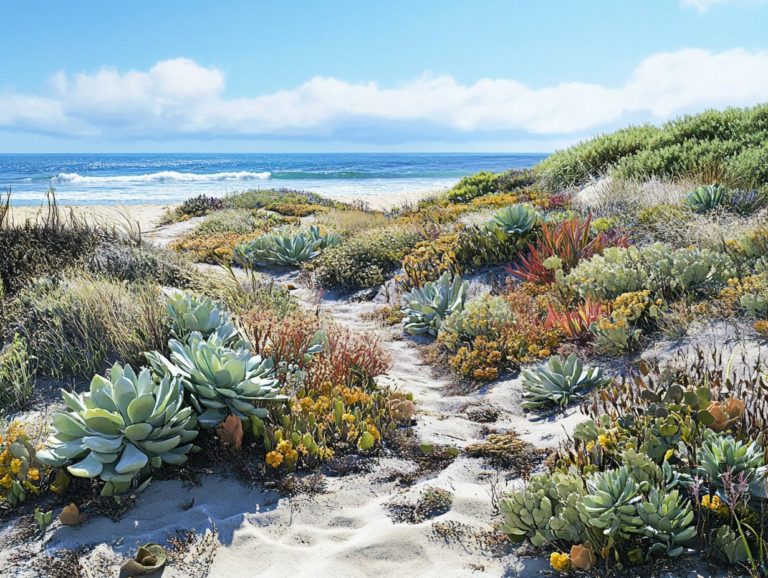What Are the Most Resilient Drought-Resistant Plants?
Drought-resistant plants are becoming essential in our changing climate, presenting a sustainable solution for your gardening and landscaping endeavors. By understanding what makes these plants resilient, you can make informed choices that not only enhance your garden but also benefit the environment.
This article delves into the characteristics of drought-resistant plants, highlighting their advantages and the diverse types you can incorporate into your landscape. It also offers valuable tips on caring for these plants, ensuring your garden thrives even in dry conditions.
Dive into this guide to discover how you can create a vibrant, water-efficient garden that flourishes with minimal resources and helps reduce your overall water usage.
Contents
- Key Takeaways:
- Understanding Drought-Resistance in Plants
- Benefits of Using Drought-Resistant Plants
- Types of Drought-Resistant Plants
- How to Incorporate Drought-Resistant Plants in Your Garden
- How to Care for Your Drought-Resistant Plants
- Frequently Asked Questions
- Which Drought-Resistant Plants Will Thrive in Your Garden?
- What are some examples of drought-resistant plants?
- Do drought-resistant plants need any water at all?
- Can drought-resistant plants be grown in any type of soil?
- Are there any flowering drought-resistant plants?
- Are there any edible drought-resistant plants?
Key Takeaways:

- Drought-resistant plants have physical adaptations such as deep root systems and succulent leaves that help them conserve water and withstand long periods of drought.
- Using drought-resistant plants in your garden not only helps the environment by conserving water but also saves you money on water bills and reduces maintenance costs.
- Native plants, xeriscaping plants (landscaping that reduces or eliminates the need for irrigation), and succulents are all excellent options for drought-resistant gardening. Proper care and watering techniques are important for maintaining the health of these plants.
Understanding Drought-Resistance in Plants
Understanding drought resistance in plants is essential, particularly in areas like the American West, where natural environments are increasingly affected by climate change. The need for drought-tolerant options is becoming more pronounced.
Drought-resistant plants are uniquely adapted to not only survive but thrive in arid conditions. If you’re interested in growing these types of plants, you might want to learn about the top drought-resistant vegetables, as they require significantly less water than conventional landscaping options.
This remarkable adaptability enables them to flourish across diverse landscapes. This makes them excellent choices for both residential and commercial gardening initiatives focused on sustainable water usage, particularly in regions affected by drought.
What Makes a Plant Drought-Resistant?
A plant qualifies as drought-resistant when it has developed unique adaptations that enable it to survive with minimal water. This makes it increasingly vital in an era marked by climate change and rising drought conditions.
These adaptations often feature deep root systems that tap into moisture reserves hidden beneath the surface. This allows them to flourish even in arid landscapes. Understanding what soil types favor drought-resistant plants is also essential, as many drought-resistant plants are equipped with waxy leaf surfaces that significantly reduce water loss through transpiration, a critical trait during dry spells.
Consider succulents like agave and cactus; they store water in their fleshy tissues, providing sustenance not only for themselves but also for the wildlife that depends on these vital water sources during drought periods, crucial in North America.
By incorporating such drought-resistant species into your landscaping, you can cultivate vibrant, sustainable gardens. These gardens conserve water and create essential habitats for birds and insects, enhancing local ecosystems.
Benefits of Using Drought-Resistant Plants
Utilizing drought-resistant plants presents a wealth of benefits, both for the environment and your wallet. These plants play a crucial role in water-wise programs designed to conserve municipal drinking water while simultaneously supporting local wildlife and enriching ecosystems.
Embracing this approach not only enhances your landscape but also contributes positively to the broader ecological community, supporting both wildlife and local agriculture. Transform your garden today with these incredible drought-resistant plants!
Environmental and Economic Benefits
Using drought-tolerant plants offers impressive environmental and economic benefits. They enhance local ecosystems and significantly contribute to water conservation, especially amid climate change.
A study by the American Society of Landscape Architects shows that by integrating drought-tolerant landscaping, you can save up to 50% more water compared to traditional plants. Take cities like Santa Fe, New Mexico, for example. They ve adopted strategies that prioritize native plant species, leading to a remarkable 30% reduction in municipal water usage.
In California’s Central Valley, rural initiatives reveal that farmers who implement these plants have reported increased resilience against drought conditions while keeping their crops healthy. By embracing such practices, you foster rich biodiversity, supporting both the vitality of the ecosystem and economic sustainability.
Types of Drought-Resistant Plants

Explore an exciting variety of drought-resistant plants available to you. Consider native varieties, innovative water-efficient landscaping choices, and distinctive species such as succulents and cacti that thrive in harsh conditions.
Each of these plays a crucial role in thriving within arid conditions, transforming landscapes into resilient, sustainable ecosystems that support local wildlife.
Native Plants
Native plants are often your best bet for drought-tolerant landscaping. They re perfectly adapted to local conditions and play a crucial role in supporting wildlife and ecosystems, particularly in regions like the intermountain West.
By incorporating species such as sagebrush, echinacea, and wild lupine, you not only conserve water but also create inviting habitats for pollinators like bees and butterflies.
These plants thrive on the natural rainfall of your area, requiring significantly less irrigation than their non-native counterparts. This keeps your water bills in check and minimizes your environmental footprint.
Native plants boost soil health by encouraging beneficial microbes, ensuring that the local ecosystem remains vibrant and resilient. With thoughtful selection, you can transform your yard into a flourishing oasis, brimming with life, even during the hottest and driest months.
Xeriscaping Plants
Xeriscaping plants are carefully chosen to create stunning landscapes while championing water conservation. They minimize the need for extra irrigation in areas prone to drought, making them perfect for California and Utah.
By employing a range of design strategies like clustering plants with similar water requirements and using mulch to retain moisture you can turn any garden into a sustainable oasis.
Choosing resilient plants that thrive in dry conditions is crucial right now for a sustainable garden! Consider lavender, agave, and native grasses. If you’re wondering where to buy drought-resistant plants locally, these options require minimal water and provide striking textures and colors throughout the seasons.
Adopting these principles enhances the beauty of your outdoor space and plays a significant role in environmental preservation by reducing excessive water usage.
Succulents and Cacti
Succulents and cacti stand out as some of the most sought-after drought-resistant plants, celebrated for their incredible ability to store water and flourish in arid conditions perfect for today s modern gardening landscape focused on sustainable practices.
These resilient wonders come in an array of shapes, sizes, and colors, adding a unique blend of textures and visual interest to your outdoor or indoor spaces. With their thick, fleshy leaves and striking spines, they conserve moisture and act as captivating focal points in gardens, pots, or any indoor setting.
Caring for these hardy companions is generally a breeze, but it s crucial to provide well-draining soil and just the right amount of sunlight to keep them thriving and prevent rot.
Discover the stunning shapes, sizes, and colors of these resilient plants today! Varieties like the vibrant Echeveria or the iconic Saguaro can seamlessly enhance both minimalist and tropical-themed spaces, highlighting the versatility that makes them a beloved choice among plant aficionados.
How to Incorporate Drought-Resistant Plants in Your Garden
Incorporating drought-resistant plants into your garden requires a thoughtful approach to design and plant selection. This also involves an overall gardening plan that champions sustainability and resilience, especially in arid regions.
Every decision you make shapes not only the aesthetic of your outdoor space but also its environmental impact. This allows you to create a thriving garden that conserves water while standing the test of time.
Design Tips and Plant Selection

Effective design tips and careful plant selection are essential when incorporating drought-resistant plants into your garden. This ensures a stunning balance of beauty and sustainability that supports wildlife.
By thoughtfully grouping plants with similar water needs, you can optimize water usage and reduce irrigation demands. Consider creating microclimates to boost your garden’s resilience; for instance, using rocks or walls to shield plants from harsh winds can support even those that are less drought-tolerant.
When choosing your plants, consider adding varieties like:
- lavender, a drought-tolerant option
- succulents
- ornamental grasses
These hardy plants not only thrive in arid conditions but also add beauty to your landscape, making them outstanding choices for any design scheme, particularly in Mediterranean climates.
How to Care for Your Drought-Resistant Plants
To maintain drought-resistant plants, you need to adopt specific care techniques and watering strategies that ensure their survival while minimizing resource use. This is especially important in regions grappling with persistent drought conditions and climate change.
By implementing these practices, you can cultivate a thriving garden that flourishes even in challenging climates.
Proper Care and Watering Techniques
Proper care and watering techniques are vital for the longevity of your drought-tolerant plants, enabling them to thrive and remain vibrant even in challenging conditions.
Utilizing methods like drip irrigation allows you to deliver water directly to the roots, minimizing evaporation losses. This ensures that every precious drop counts. Adding mulch around the base of your shrubs and trees will effectively retain moisture in the soil, reducing your need for frequent watering.
Timing also plays a significant role; watering early in the morning or late in the afternoon helps prevent excessive evaporation caused by the heat of the day.
It’s essential to remember that different drought-resistant varieties, especially those suited for North America, may have specific care needs. Understanding these nuances will help you optimize their growth and resilience across various climates.
Frequently Asked Questions
Which Drought-Resistant Plants Will Thrive in Your Garden?
Drought-resistant plants, also known as xerophytes (plants that can survive with very little water), are great choices for gardens in areas like Idaho, Utah, and California with limited water resources. If you’re curious about how long these plants typically thrive, check out what is the lifespan of drought-resistant plants. Here are some of the most resilient drought-resistant plants:
What are some examples of drought-resistant plants?

Some examples of drought-resistant plants include perennials like succulents, cacti, lavender, agave, and yucca. For those interested in landscaping, knowing the most resilient drought-tolerant grasses can also be beneficial, as these plants have adapted to survive in dry conditions by storing water in their leaves, stems, or roots.
Do drought-resistant plants need any water at all?
While drought-resistant plants can survive with minimal water, they do still require some. During periods of extended drought, it s important to give these plants a deep watering once a week to help them thrive.
Start your water-wise gardening journey today!
Can drought-resistant plants be grown in any type of soil?
Yes, most drought-resistant plants, especially those from the intermountain West, can thrive in various soil types. They need well-draining soil and benefit from added organic matter for nutrients.
Are there any flowering drought-resistant plants?
Absolutely! Many stunning drought-resistant plants bloom with vibrant flowers, ideal for gardens in California and the Mediterranean. Examples include coneflowers, black-eyed Susans, salvia, and verbena.
These plants brighten up your garden and attract pollinators.
Are there any edible drought-resistant plants?
Yes! There are several edible options, like those native to the American West, that flourish in dry climates. Rosemary, thyme, sage, and oregano are great choices.
These herbs not only spice up your meals, but they also thrive with minimal water.






